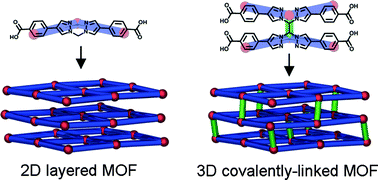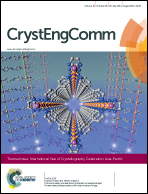Utilising hinged ligands in MOF synthesis: a covalent linking strategy for forming 3D MOFs†
Abstract
Here we show that connecting two equivalents of a bis-pyrazolymethane ‘hinged’ link by a carbon–carbon bond characteristically ‘extends’ the 2D layered metal–organic frameworks (MOFs) typically formed with such compounds into 3D MOF materials. 1,1,2,2-Tetrakis[4-(4-carboxyphenyl)-1H-pyrazol-1-yl]ethane (L) was prepared in three steps and upon reaction with late transition metals, namely copper(II), cadmium(II) and zinc(II), gave 3D MOFs [Cu2(L)(H2O)2] 1.4DMF and [M2L]·xDMF (M = Zn, x = 1; M = Cd, x = 1.75). The 3D MOFs display gating behaviour in their adsorption isotherms, consistent with 3rd generation flexible structures. Furthermore, the 3D MOFs showed appreciable affinity for CO2 at 293 K however, due to the larger pore sizes, molecular sieving of CO2/N2 was not observed. Reaction of L with cobalt(II) gave a 3D hydrogen-bonded network incorporating 1D coordination polymer chains that is topologically equivalent to the Zn and Cd MOFs. The strategy outlined here demonstrates a novel route for designing more chemically and thermally robust 3D MOFs from 2D layered materials.

- This article is part of the themed collection: International Year of Crystallography Celebration: Asia-Pacific

 Please wait while we load your content...
Please wait while we load your content...